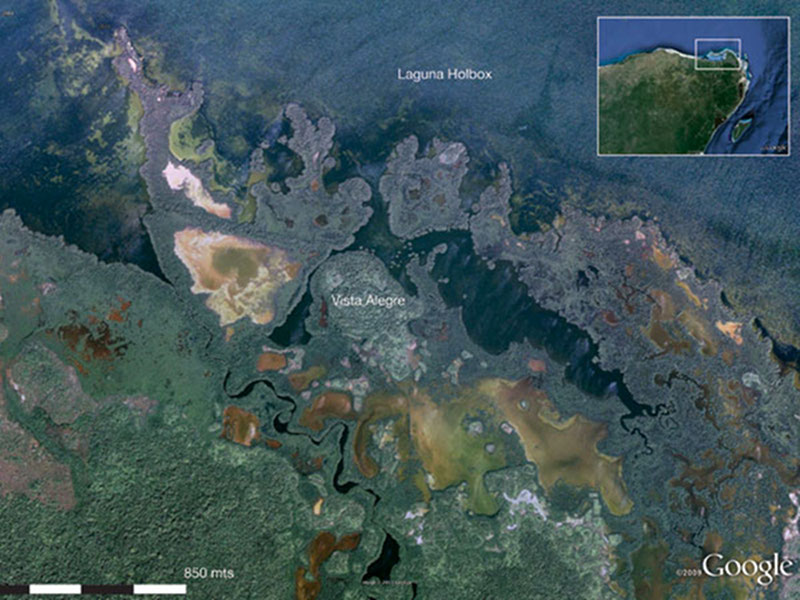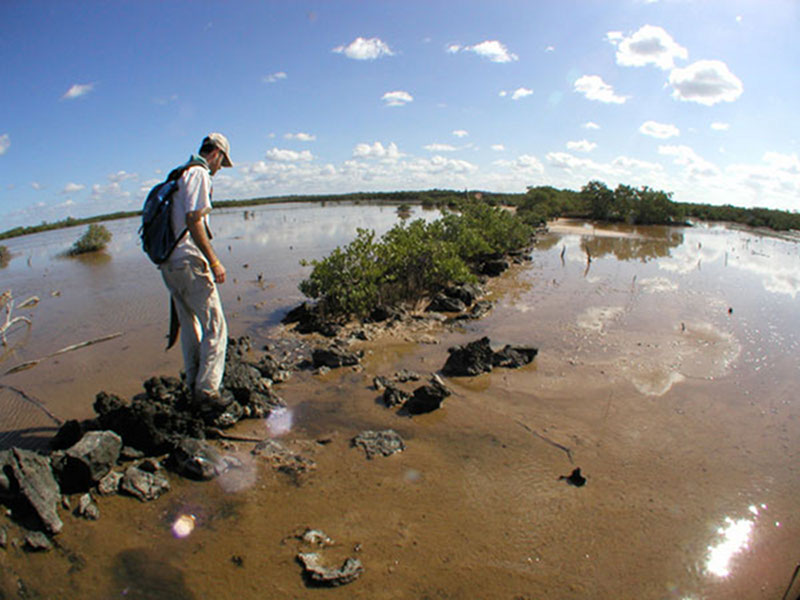
By Jeffrey B. Glover, PhD, Assistant Professor - Department of Anthropology, Georgia State University
The Maritime Maya Project 2011 is an interdisciplinary exploration project focused on the ancient Maya port site of Vista Alegre. By integrating environmental and archaeological sciences, the project explores –

Aerial map showing a portion of Laguna Holbox where Vista Alegre is located. Image courtesy of Proyecto Costa Escondida Maritime Maya 2011 Expedition, NOAA-OER. Download larger version (jpg, 11.4 MB).
During the periods of occupation at Vista Alegre over the last 3000 years, global sea level has been a maximum of 2 m lower than present and slowly rising. Maya settlements over this time would have had to adjust to not only the shifting position of the coastline, but also the disappearance of coastal springs and declining quality of the discharging freshwater. The need for freshwater is an obvious concern for coastal peoples and during our previous fieldwork in the area we have identified several potential potable water sources that are yet to be characterized for their volume and salinity and how these factors change over tidal and seasonal cycles. The majority of freshwater exits into the ocean through submarine springs, which locally are called, ojos de aqua (eyes of water). We are familiar with several point discharges along the north and east coasts that discharge large volumes of water, with some sites estimated to be second order magnitude springs (1 m3/s) or larger. In fact, Francisco de Montejo, the Spanish Conquistador who founded Merida, reported during his first attempt to conquer the Yucatan that he watered his horses at one of these places along Quintana Roo’s north coast. But, did such a major spring exist in close proximity to Vista Alegre?
We have recorded a number of ojos de agua along the north coast, but none of them are close enough to Vista Alegre to have been viable daily sources for the site’s water needs. The largest of these that we have visited is located ~14.5 km to the west of Vista Alegre, while the others are not sizeable and are located ~6.5 km away. We have furthermore identified four very small cenotes (limestone sinkholes that access the water table) to the south of the archeological site, and more may yet be found in the area. While these cenotes would have provided year round freshwater, and clearly have been used as evidenced by the historical glass bottles and pots present, their location 2.8 km south of the site's main habitation areas make us doubtful that they were the principal water sources for Vista Alegre. We believe that a closer, permanent water source must exist.
Physico-chemical characterization of accessible surface and groundwater will be completed using a calibrated multi-parameter probe (Hydrolab). The information will include data on water temperature, conductivity/salinity, pH, dissolved oxygen, and Eh (redox – reduction oxidation is an electrical measure of the oxidation potential in sediments which allows for the assessment of aerobic or anaerobic conditions). An internally logging SENSUS temperature and depth sensor set to collect data at 15 minute intervals will be placed for about six months to monitor the response of the discharging freshwater from key spring sites with respect to tides, barometric pressure, and also to individual rain events, thus generating a model of seasonal changes. The Yucatan groundwater is 2°C cooler than the coastal marine water and therefore temperature can be calibrated as a salinity proxy for this region, as has been previously effectively done for the Caribbean coast.
The culmination of this fieldwork and analysis will be the development of an integrated model of coastal environmental change, identifying the location, quantity, and quality, of potable water resources in the present condition, and importantly how these key factors have changed over the last 10,000 years.
The coring program will also be the key to our sedimentological and hydrogeochemical analyses. These cores, taken around Vista Alegre, will characterize the near shore sediments (their aqueous geochemistry and the Eh redox readings) to determine the preservation potential for woody material over 500 – 2000 years. This will establish the likelihood of finding a canoe that might have been lost in port during a storm event or derelict watercraft that were abandoned and eventually settled on the bottom of the shallow harbors. Though we will not be conducting an underwater archaeological survey, per se, the characterization of harbor sediments is a requisite precursor to a future program of hydro-probing using a water jet and magnetic mapping to discover buried anomalies that alter the earth’s magnetic field.
Through these cores we are also optimistic about the possibility of identifying and dating past hurricane events. The impact of hurricanes would not have been lost on the Maya of Vista Alegre, and there is even intriguing glyphic evidence that the Classic Maya not only recognized these events but recorded them in writing. The burgeoning field of paleotempestology (the study of past storm events) has successfully documented these dramatic storms via geologic proxies in various parts of the world. While some attempts have been made to reconstruct the history of hurricanes along the Quintana Roo coastline, they have had limited success to date. Given the massive defoliation of the near coast vegetation from recent past hurricanes that we have witnessed, any records along the north coast will most likely be from this massive influx of organic matter during such events and should be recognizable in the estuarine strata. We then hope to correlate the timing of these past events with the chronology of the site to determine if these events may have had impacts on the settlement history of the site.
The contemporary ecological zones of the Quintana Roo coastline are a complex mosaic of habitat types influenced by dynamic environmental processes and past socio-economic land use. Although interpreting the intricate relationships between organisms and their environments can be complicated by the variation in ecological communities caused by disturbances (e.g. hurricanes, droughts) and past human interventions, we believe this initial exploratory characterization of the Vista Alegre site and surrounding environs will yield valuable insights into the reconstruction of past ecological habitats and their uses as well as changes through time across the entire region.

The andador running south across the tidal flats towards the mainland and Templo Perdido. In this picture one can clearly see the remains of the andador. The coarse rubble fill was probably covered by pulverized limestone (sascab) or dirt to create a smooth walking surface. Image courtesy of Proyecto Costa Escondida Maritime Maya 2011 Expedition, NOAA-OER. Download larger version (jpg, 2.0 MB).
Our focus on the shifting form and function of the coastline over the period of human occupation will involve near-shore and estuarine science activities. The plan is for the complete team to arrive at Vista Alegre May 10th and promptly begin field research oriented to address the exploration objectives. Derek Smith, the coastal ecologist, will set out with a GPS unit and a canoe to begin the process of characterizing the mosaic of ecological zones that surround Vista Alegre. The coring program will begin as well in the harbor areas. Given the remoteness of the location some of the equipment is being fashioned from available resources. The floating coring platform will consist of two small boats lashed together by a few 2” x 8” pieces of wood. This platform will then be paddled or towed around (by canoe) to various sampling locales. In addition, Patricia Beddows, the hydrogeologist, will begin her survey of various freshwater outlets. While these activities are underway, detailed mapping of the natural and cultural features at Vista Alegre will be conducted. One goal is to map in detail the sacbe (road)/wall feature that crosses the island east/west and extends into the harbors. The interdisciplinary team is set to make a major impact on our understanding of the ecology and hydrogeology of this forgotten section of coastline and in the process help us better understand how the ancient Maya inhabitants made a living at this coastal port over millennia.